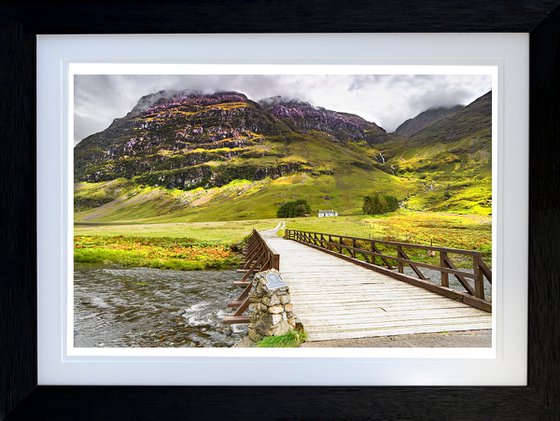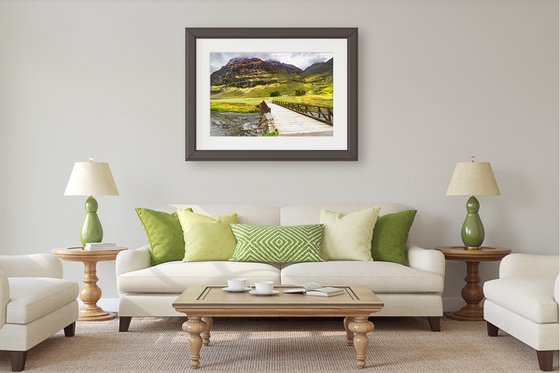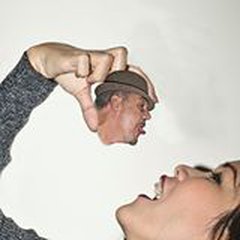- By medium
- By subject
- By budget
- Sales
- Gift cards
- Discover all art
- Artists
- Editors’ picks
- Ideas
Artwork description:
Achnambeithach Cottage at the Foot of Aonach Dubh, is an iconic scene in Glencoe, in the Western Scottish Highlands. Glencoe is one of the most beautiful places that I have ever visited. It is just as eerie, though, as it is the site of one of the most dastardly deeds in recorded history.
n 27 August 1691 King William offered the Highland clans a pardon for their part in the Jacobite rising - if they agreed to pledge allegiance to him before New Year’s Day. The oath had to be made before a magistrate. Many Highland Chiefs waited for word to come from the exiled King James before they took the oath.
Alasdair MacIain, the Chief of Glencoe, arrived at Fort Willliam on 31 December 1691 to take the oath but was told that he would have to travel some 70 miles to the sheriff at Inveraray. MacIain finally took the oath on 6 January 1692. He was given assurances that his allegiance would be accepted and that he and his people - the McDonalds of Glencoe - were safe.
John Dalrymple, Master of Stair, was the Secretary of State. He was hoping for an excuse to make an example of one of the Highland Clans. When he heard that Alasdair MacIain had not sworn allegiance by 31 December he was delighted:
My Lord Argyle tells me that Glencoe has not taken the oath, at which I rejoice. It is a great work of charity to be exact in the rooting out of that damnable sect, the worst in all the Highlands.
On 2 February about 120 troops arrived at Glencoe under the command of Captain Robert Campbell of Glenlyon. They were given hospitality by the MacDonalds of Glencoe as was customary in the Highlands. For the next 10 days and nights the troops were given food, drink and lodgings.
On 12 February Glenlyon received written orders from his superior, Major Duncanson:
You are hereby ordered to fall upon the rebels, the McDonalds of Glencoe, and put all to the sword under seventy. You are to have a special care that the old Fox and his sons do upon no account escape your hands, you are to secure all the avenues that no man escape.
At 5 am on the morning of 13 February 1692 the killing began. Alasdair MacIain of Glencoe was shot dead as he rose from his bed, his wife was dragged away from her fallen husband and stripped naked. She died the next day. Houses were set alight. The troops bound some captives hand and foot before killing them. Gunfire woke the people of Glencoe. They ran from their homes and fled into the mountains.
Thirty eight men, women and children were killed in the massacre. Many more died of exposure as they tried to escape across the mountains in the dead of winter.
The MacDonalds had been victims of ‘murder under trust’, considered even worse than normal acts of murder under Scots law. The Massacre of Glencoe was also an act of terror by the state against its own people. The MacDonalds were killed to scare the other Highland Clans into submission. John Dalrymple, Master of Stair, had planned the murders. The orders to kill the MacDonalds of Glencoe had been signed by King William.
As word of the massacre spread, the Government tried to cover up what had happened. Eventually, in 1695, King William had to launch an enquiry. The Master of Stair resigned his offices and was given a Government pension. Robert Campbell of Glenlyon died in poverty a year later. No-one was ever brought to trial.
On my visit, I was entranced by the beauty, and history of the place. I felt, as I walked among the heather, that I was treading on hallowed ground. The heavy overcast sky only added to the aura.
Materials used:
Baryta 300gsm Archival paper, Solid Wood frame, Archival Double Mount, anti reflective clear acrylic
Tags:
#scotland #glencoe #glencoe massacre #clan mcdonald #river coupall #achnambeithach cottageAchnambeithach Cottage - Glencoe Valley Western Scottish Highlands (2021)
Photograph
by Michael McHugh
£315
- Photograph on Paper
- From a limited edition of 10
- Size: 62.7 x 47 x 2cm (framed) / 45.5 x 30cm (actual image size)
- Framed and ready to hang
- Signed and numbered certificate of authenticity
- Style: Photorealistic
- Subject: Landscapes, sea and sky
Artwork description
Achnambeithach Cottage at the Foot of Aonach Dubh, is an iconic scene in Glencoe, in the Western Scottish Highlands. Glencoe is one of the most beautiful places that I have ever visited. It is just as eerie, though, as it is the site of one of the most dastardly deeds in recorded history.
n 27 August 1691 King William offered the Highland clans a pardon for their part in the Jacobite rising - if they agreed to pledge allegiance to him before New Year’s Day. The oath had to be made before a magistrate. Many Highland Chiefs waited for word to come from the exiled King James before they took the oath.
Alasdair MacIain, the Chief of Glencoe, arrived at Fort Willliam on 31 December 1691 to take the oath but was told that he would have to travel some 70 miles to the sheriff at Inveraray. MacIain finally took the oath on 6 January 1692. He was given assurances that his allegiance would be accepted and that he and his people - the McDonalds of Glencoe - were safe.
John Dalrymple, Master of Stair, was the Secretary of State. He was hoping for an excuse to make an example of one of the Highland Clans. When he heard that Alasdair MacIain had not sworn allegiance by 31 December he was delighted:
My Lord Argyle tells me that Glencoe has not taken the oath, at which I rejoice. It is a great work of charity to be exact in the rooting out of that damnable sect, the worst in all the Highlands.
On 2 February about 120 troops arrived at Glencoe under the command of Captain Robert Campbell of Glenlyon. They were given hospitality by the MacDonalds of Glencoe as was customary in the Highlands. For the next 10 days and nights the troops were given food, drink and lodgings.
On 12 February Glenlyon received written orders from his superior, Major Duncanson:
You are hereby ordered to fall upon the rebels, the McDonalds of Glencoe, and put all to the sword under seventy. You are to have a special care that the old Fox and his sons do upon no account escape your hands, you are to secure all the avenues that no man escape.
At 5 am on the morning of 13 February 1692 the killing began. Alasdair MacIain of Glencoe was shot dead as he rose from his bed, his wife was dragged away from her fallen husband and stripped naked. She died the next day. Houses were set alight. The troops bound some captives hand and foot before killing them. Gunfire woke the people of Glencoe. They ran from their homes and fled into the mountains.
Thirty eight men, women and children were killed in the massacre. Many more died of exposure as they tried to escape across the mountains in the dead of winter.
The MacDonalds had been victims of ‘murder under trust’, considered even worse than normal acts of murder under Scots law. The Massacre of Glencoe was also an act of terror by the state against its own people. The MacDonalds were killed to scare the other Highland Clans into submission. John Dalrymple, Master of Stair, had planned the murders. The orders to kill the MacDonalds of Glencoe had been signed by King William.
As word of the massacre spread, the Government tried to cover up what had happened. Eventually, in 1695, King William had to launch an enquiry. The Master of Stair resigned his offices and was given a Government pension. Robert Campbell of Glenlyon died in poverty a year later. No-one was ever brought to trial.
On my visit, I was entranced by the beauty, and history of the place. I felt, as I walked among the heather, that I was treading on hallowed ground. The heavy overcast sky only added to the aura.
Materials used:
Baryta 300gsm Archival paper, Solid Wood frame, Archival Double Mount, anti reflective clear acrylic
Tags:
#scotland #glencoe #glencoe massacre #clan mcdonald #river coupall #achnambeithach cottageReturns and refunds
We want you to love your art! If you are not completely satisfied with your purchase you can return it free within 14 days, no questions asked. Learn more
This artwork is sold by Michael McHugh from United Kingdom




